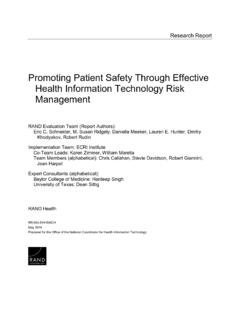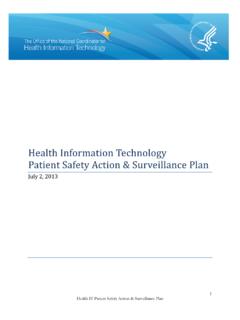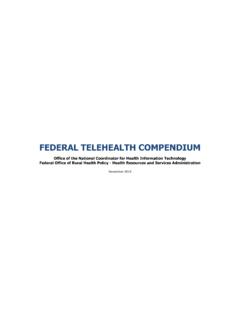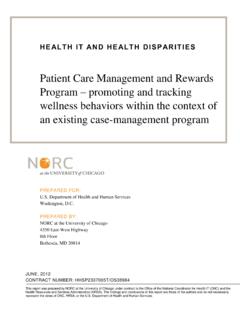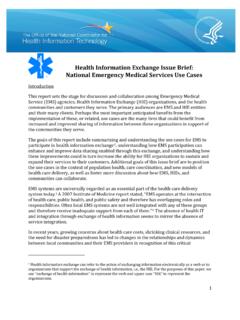Transcription of Adoption of Electronic Health Record Systems among U.S ...
1 ONC Data Brief No. 23 April 2015. Adoption of Electronic Health Record Systems among Non- Federal Acute Care Hospitals: 2008 -2014. Dustin Charles, MPH; Meghan Gabriel, PhD; Talisha Searcy, MPA, MA. The Health Information Technology for Economic and Clinical Health (HITECH) Act of 2009. directed the Office of the National Coordinator for Health Information Technology (ONC) to promote the Adoption and meaningful use of Electronic Health records (EHRs). In addition, the Adoption and increased use of Health IT products is a keystone objective of the Federal Health IT. Strategic Plan (1). This brief describes trends in Adoption of EHR Systems among non-federal acute care hospitals from 2008 to 2014. It tracks both the Adoption of Basic EHR Systems and the possession of EHR technology certified to meet federal requirements. Basic EHR Adoption represents a minimum use of core functionality determined to be essential to an EHR system (see Table A1).
2 This brief refers to Basic EHR Adoption with clinical notes unless otherwise stated. A. certified EHR is EHR technology that meets the technological capability, functionality, and security requirements adopted by the Department of Health and Human Services. Three out of Four Hospitals have a Basic EHR System. Figure 1: Percent of non-Federal acute care hospitals with Adoption of at least a Basic EHR with notes system and possession of a certified EHR: 2008 -2014. NOTES: Basic EHR Adoption requires the EHR system to have a set of EHR functions defined in Table A1. A certified EHR is EHR technology that meets the technological capability, functionality, and security requirements adopted by the Department of Health and Human Services. Possession means that the hospital has a legal agreement with the EHR vendor, but is not equivalent to Adoption .
3 *Significantly different from previous year (p < ). SOURCE: ONC/American Hospital Association (AHA), AHA Annual Survey Information Technology Supplement . In 2014, 3 out of 4 (76%) hospitals had adopted at least a Basic EHR system. This represents an increase of 27% from 2013 and an eight-fold increase since 2008 . Nearly all reported hospitals (97%) possessed a certified EHR technology in 2014, increasing by 35% since 2011. For all states, at least half of hospitals adopted a Basic EHR. Table 1: Percent of non-federal acute care hospitals with Adoption of at least a Basic EHR system by State, 2014. State Basic EHR, % n (N) State Basic EHR, % n (N). United States 2682 (4451) Missouri 111(111). Alabama 35(89) Montana 27(54). Alaska 7(21) Nebraska 48(84). Arizona 31(62) Nevada 13(30). Arkansas 35(71) New Hampshire 17(26). California 170(325) New Jersey 44(64).
4 Colorado 50(71) New Mexico 18(32). Connecticut 22(29) New York 110(170). Delaware 5(6) North Carolina 60(106). District of Columbia 6(8) North Dakota 14(41). Florida 119(182) Ohio 100(154). Georgia 66(130) Oklahoma 47(105). Hawaii 12(22) Oregon 36(59). Idaho 19(38) Pennsylvania 107(154). Illinois 126(177) Rhode Island 6(10). Indiana 61(107) South Carolina 26(58). Iowa 85(117) South Dakota 22(51). Kansas 92(125) Tennessee 52(114). Kentucky 60(96) Texas 231(342). Louisiana 42(98) Utah 21(44). Maine 19(34) Vermont 5(14). Maryland 33(45) Virginia 51(80). Massachusetts 36(62) Washington 32(89). Michigan 83(128) West Virginia 24(49). Minnesota 124(128) Wisconsin 82(125). Mississippi 25(90) Wyoming 15(24). NOTES: Basic EHR Adoption requires the EHR system to have a set of EHR functions defined in Table A1. n = survey respondents; N = hospitals surveyed.
5 All estimates met standards for reliability. Significantly higher than national average Significantly lower than national average (p < ). SOURCE: ONC/AHA, AHA Annual Survey Information Technology Supplement State rates of hospital Adoption of at least a Basic EHR system ranged from 50% to 100%. Delaware (100%), South Dakota (95%), and Virginia (93%) had the highest percent of hospitals with Adoption of at least a Basic EHR system. West Virginia (50%), Hawaii (55%), and Kansas (60%) had the lowest percent of hospitals with Adoption of at least a Basic EHR system. ONC Data Brief No. 23 | Adoption of Electronic Health Record Systems among 2. Non-Federal Acute Care Hospitals: 2008 -2014. State Adoption rates have increased from 2008 to 2014. Figure 2: State percent of non-federal acute care hospitals with Adoption of at least a Basic EHR system compared with prior years.
6 NOTES: Basic EHR Adoption requires the EHR system to have at least a basic set of EHR functions, including clinician notes, as defined in Table A1. Estimates for states shaded gray did not meet the standards for reliability (NR). See the Table A2 for a complete list of 2008 and 2011 hospital Adoption by state. SOURCE: ONC/AHA, AHA Annual Survey Information Technology Supplement In 2008 , hospital Adoption of at least a Basic EHR system was above 20% in only 2. states (Connecticut and New Mexico). Three years later, hospital Adoption of at least a Basic EHR system was above 20% in 32. states and above 40% in 7 states. In 2014, hospital Adoption of at least a Basic EHR system was above 60% in all but 2. states (Hawaii and West Virginia), and above 80% in 17 states. ONC Data Brief No. 23 | Adoption of Electronic Health Record Systems among 3.
7 Non-Federal Acute Care Hospitals: 2008 -2014. Trends in EHR Adoption show increasing use of advanced functionality. Figure 3: Percent of non-federal acute care hospitals with Adoption of EHR Systems by level of functionality: 2008 - 2014. NOTES: Definitions of Basic EHR and Comprehensive EHR Systems are reported in Table A1. *Significantly different from previous year (p < ). SOURCE: ONC/AHA, AHA Annual Survey Information Technology Supplement. Fewer hospitals are using Basic EHRs without Clinician Notes, while the Systems with more advanced functionality have increased significantly. Hospital Adoption of Comprehensive EHR Systems has increased eleven-fold since 2009, rising to a third ( ) of hospitals in 2014. ONC Data Brief No. 23 | Adoption of Electronic Health Record Systems among 4. Non-Federal Acute Care Hospitals: 2008 -2014.
8 Summary Adoption of EHR Systems by non-federal acute care hospitals has steadily increased since HITECH. Basic EHR Adoption represents a minimum use of core functionality determined to be essential to an EHR system (2). In 2014, 3 in 4 (76%) non-federal acute care hospitals had adopted at least a Basic EHR system with clinician notes. This represents a 27% increase from the previous year and a more than eight-fold increase in EHR Adoption since 2008 . At 16. percentage points higher than 2013, this is the second highest increase in Adoption since 2012 (17. percentage points). Moreover, since the passage of the HITECH Act in 2009, state EHR Adoption rates have increased. EHR Adoption rates increased from only 2 states reporting rates higher than 20% to all states reporting rates 50% or higher by 2014. Furthermore, only 2 states currently have Adoption rates below 60%.
9 In addition to growth in EHR Adoption overall, hospital Adoption of technology with advanced functionality increased significantly. While fewer hospitals used Basic EHR Systems without clinician notes, significantly more adopted Systems with clinician notes. Additionally, over a third of hospitals were using more advanced EHR functionality. Hospital Adoption of Comprehensive EHR Systems has increased more than eleven-fold in the last five years. Finally, a vast majority of acute care hospitals (97%) possessed EHR technology certified to meet federal requirements. These hospitals should have the technology needed to meet EHR. Incentive Program objectives. These Systems are also certified to be secure and able to work with other certified Systems to share information. Thus, the increase in the rate of Adoption for certified EHR technology shed a positive light on hospitals' progress towards the interoperable exchange of Health information.
10 ONC Data Brief No. 23 | Adoption of Electronic Health Record Systems among 5. Non-Federal Acute Care Hospitals: 2008 -2014. Definitions Non-federal acute care hospital: Includes acute care general medical and surgical, general children's, and cancer hospitals owned by private/not-for-profit, investor-owned/for-profit, or state/local government and located within the 50 states and District of Columbia. The inclusion of children's general and cancer hospitals makes this definition different from previous peer- reviewed research (3). However, it is more consistent with the population of hospitals eligible for federal Health IT Adoption incentives. Adoption of Basic EHR: Table A1 defines the Electronic functions required for hospital Adoption of a Basic or Comprehensive EHR system, which a consensus expert panel established (2).
